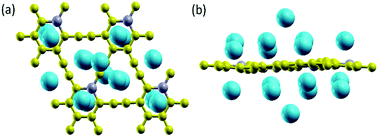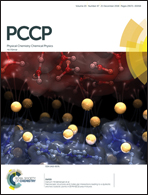Ab initio study of sodium diffusion and adsorption on boron-doped graphyne as promising anode material in sodium-ion batteries
Abstract
The electronic properties, adsorption energies and energy barrier of sodium ion diffusion in B-doped graphyne (BGY) are studied by density functional theory (DFT) method. If some carbon atoms in pristine graphyne (GY) are substituted by boron atoms (one substitution per unit cell in this work), BGY is obtained, and the band structure and density of state (DOS) plots indicate a transition from a semiconductive state for GY to a metallic state for BGY. The calculated adsorption energy shows an improvement in the trigonal-like pore (T site) and hexagonal ring (H site) adsorption of BGY compared to the corresponding analog sites in GY. The comparison of projected density of state (PDOS) plots before and after adsorption reveals charge transfer from sodium to nanosheets. Therefore, the interaction between adsorbed sodium atom and BGY/GY has ionic character and not covalent. This phenomenon is important for the reversible sodium adsorption in secondary batteries. Moreover, PDOS plots show that the electron transfer from sodium atom to host structure in BGY is more than in GY, which is in agreement with adsorption energies. According to diffusion energy barrier calculations, boron atoms in BGY structure provide low energy paths for sodium ions diffusion. We estimate a theoretical capacity of 751 mA h g−1 for the maximum sodium adsorption on BGY (without cluster formation). Therefore, BGY is a promising anode material for sodium ion batteries (SIBs).



 Please wait while we load your content...
Please wait while we load your content...